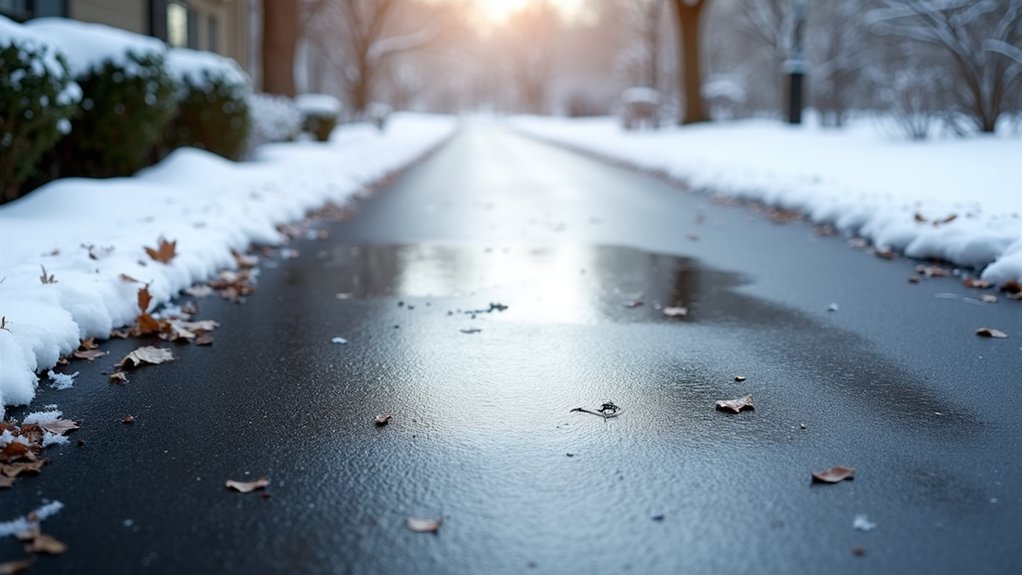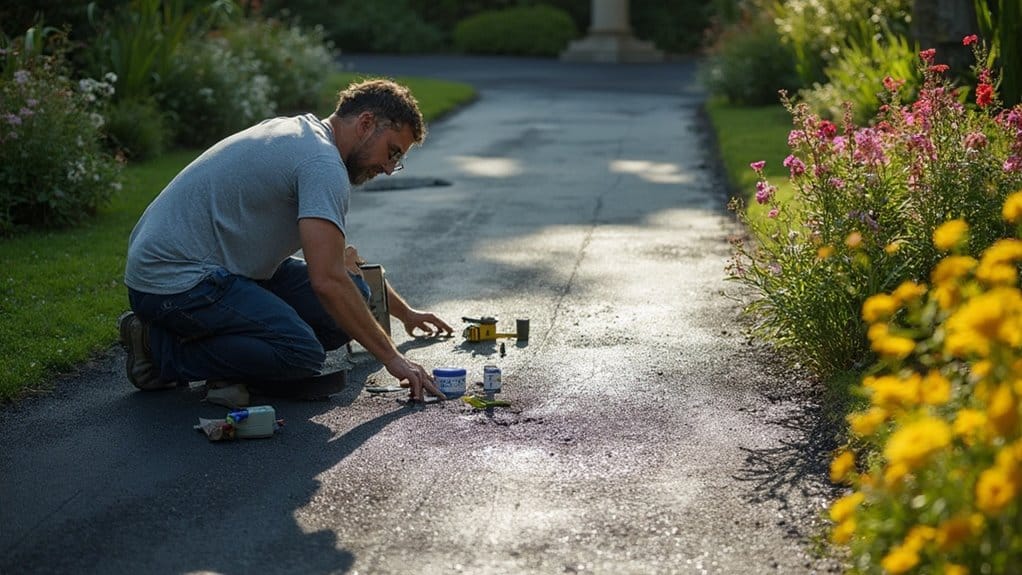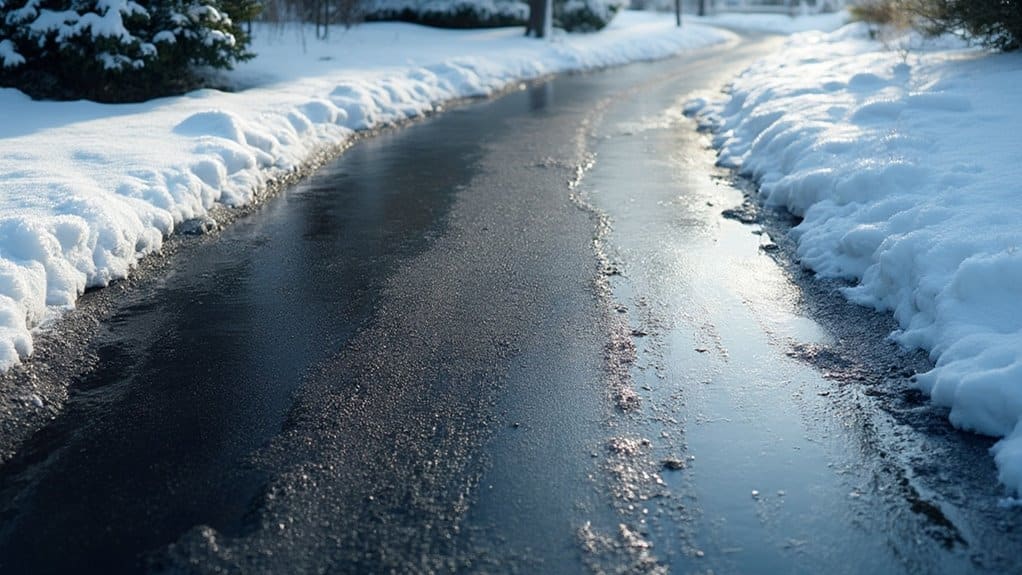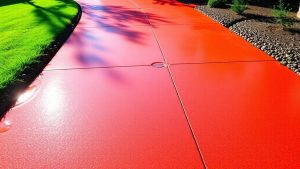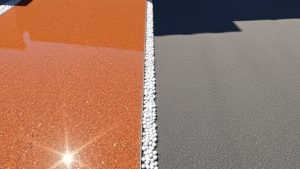Sealing your driveway before winter is crucial. It protects against severe weather, prevents freeze-thaw cycles that can create cracks, and can extend its lifespan by 10% to 25%. Additionally, it helps maintain a neat appearance and enhances curb appeal. To ensure effective sealing, proper preparation is vital—this includes cleaning and addressing any damage. Neglecting this step can result in expensive repairs down the line. Want to learn more about the benefits and tips for successful sealcoating? Keep reading!
Table of Contents
ToggleKey Takeaways
Sealing your driveway before winter offers essential protection against harsh weather conditions, helping to prevent freeze-thaw cycles that can lead to cracks in the asphalt. It can extend your driveway’s lifespan by 10% to 25%, saving you money on future repairs.
Sealcoating also minimises the risk of potholes and damage caused by ice and snow build-up. Additionally, a sealed driveway helps to deter weed and moss growth, keeping it looking tidy throughout the winter months.
Moreover, maintaining a well-sealed driveway can enhance your property’s value, reflecting good upkeep and care on your part as a homeowner.
Advantages of Sealing a Driveway Before Winter

As winter approaches, sealing your driveway can help avoid expensive repairs later on.
Driveway sealing acts as a protective barrier against harsh weather, preventing freeze-thaw cycles that can crack your asphalt. By stopping water from penetrating, you’ll reduce damage from ice and snow, lowering the risk of potholes. Additionally, seal coating can extend the life of your driveway by 10% to 25%, which means more time before needing costly replacements. Regular sealing also discourages weed and moss growth, maintaining the driveway’s integrity and appearance.
This simple step not only extends your driveway’s lifespan but also cuts down on long-term costs. Sealed surfaces are more resistant to oil and de-icing chemicals, keeping your driveway in good condition.
Plus, it means less disruption from repairs, making budgeting easier. Investing in sealing now means fewer headaches later—ensuring your driveway remains durable and safe throughout the winter.
Don’t delay; protect your investment today!
Optimal Conditions for Sealing
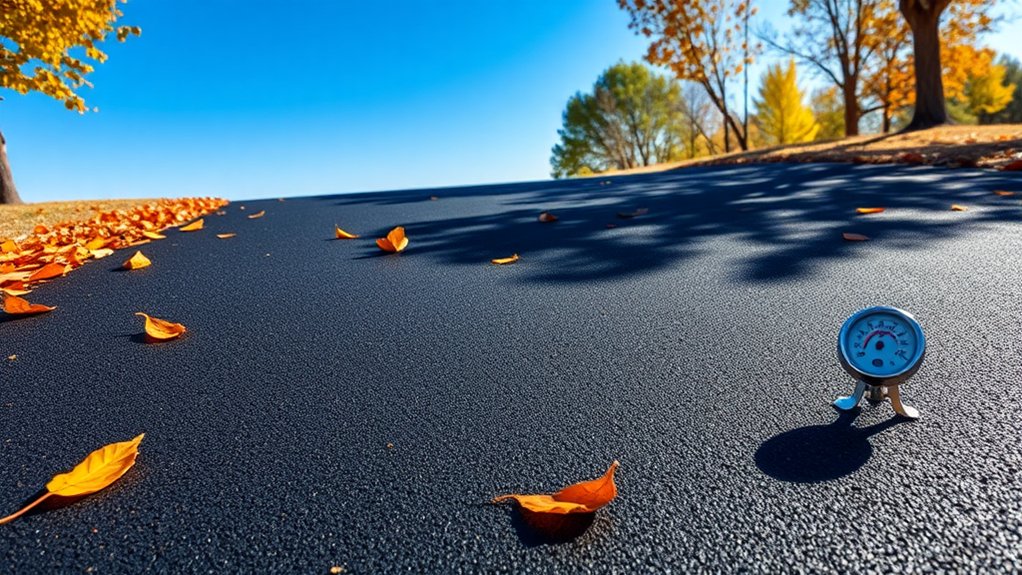
For the best results when sealing your driveway, it’s important to consider the ideal conditions for application. Aim for air and surface temperatures between 10°C and 32°C for effective sealcoat application. Mornings around 21°C that increase throughout the day promote quicker drying. Avoid sealing when temperatures dip below 13°C for 48 hours after application to ensure proper curing. Additionally, choose dry weather with no rain forecasted for at least 24 hours post-sealing. A clean, dry surface is crucial; any moisture can cause peeling or bubbling. Planning your sealing project between spring and early autumn will enhance durability and effectiveness, helping your driveway withstand the challenges of winter. Sealcoating is recommended every 3-4 years to ensure optimal protection for your driveway.
Preparation Steps for Sealing
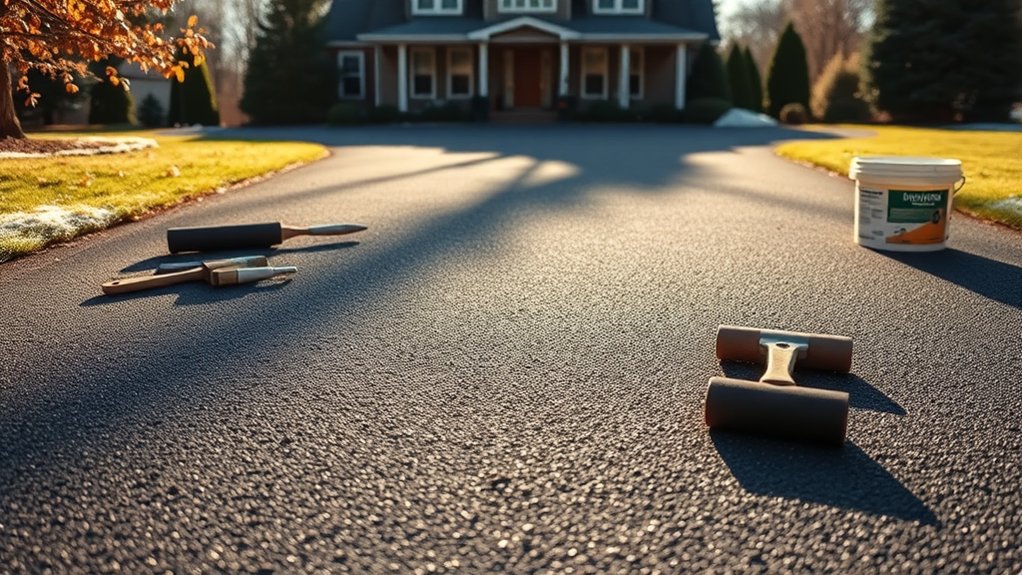
Before sealing your driveway, it’s crucial to prepare the surface properly for the best results. Start with a thorough assessment; look for cracks, potholes, and any other damage. Cracks indicate potential underlying issues requiring attention, so be vigilant during your inspection.
Clean the driveway by sweeping away debris with a broom or using a leaf blower. For oil stains, apply a degreaser, and then pressure wash the entire surface. Ensure the driveway is completely dry before proceeding.
Next, repair any damage: use crack fillers for cracks larger than 6mm and asphalt patch compounds for potholes. Inspecting your asphalt driveway for damage helps to identify issues that may need attention before sealing. It’s also essential to address poor drainage to prevent water accumulation that could weaken the tarmac structure over time.
Check that the drainage system is clear to avoid water pooling. Finally, decide on the sealing techniques you’ll employ to apply the sealer effectively.
Proper preparation is key to maximizing the effectiveness of your sealing efforts.
Benefits of Early Action
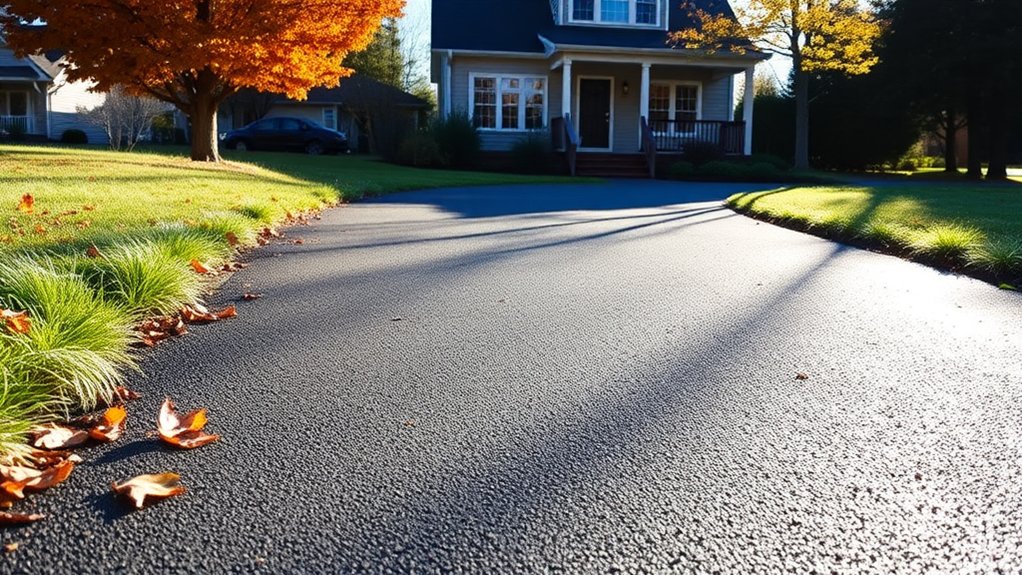
Taking early action by sealing your driveway can save you money in the long run.
By stopping small cracks from developing into larger issues, you help maintain the strength of your pavement during harsh winter weather.
This sensible step not only protects your investment but also prolongs the lifespan of your driveway. Additionally, proper maintenance like sealing can significantly enhance the overall durability of your driveway, ensuring it withstands extreme weather conditions effectively.
Cost Savings
Sealing your driveway before winter can lead to considerable cost savings, making it a wise investment. Here are the key benefits:
- Lower Repair Costs: Sealcoating prevents moisture and chemicals from penetrating, which reduces the risk of cracks and expensive repairs.
- Long-Term Savings: Regular sealcoating extends the life of your driveway, delaying the need for costly replacements.
- Protection Against Ice and Salt Damage: A properly sealed surface withstands freeze-thaw cycles, reducing the need for harsh de-icing chemicals that can cause damage.
Investing in sealcoating not only ensures durability but also cuts down on long-term maintenance expenses.
It’s a smart move that enhances your driveway’s lifespan and can even increase your property’s value.
Structural Integrity Maintenance
Sealing your driveway early significantly improves its structural integrity, helping it endure harsh winter conditions. A sealant acts as a moisture barrier, preventing water absorption and reducing the risk of cracking and surface erosion.
By managing moisture effectively, you maintain the internal strength of the concrete, which can save you from costly repairs down the line.
Sealing also protects against freeze-thaw cycles, ensuring a smooth, even surface and reducing the likelihood of potholes. This proactive measure helps maintain the edges and supports your driveway’s load-bearing capacity.
Overall, sealing enhances your driveway’s durability and longevity, making it easier to care for while also improving its appearance.
Don’t delay—protect your investment and keep your driveway in top shape.
Common Mistakes to Avoid
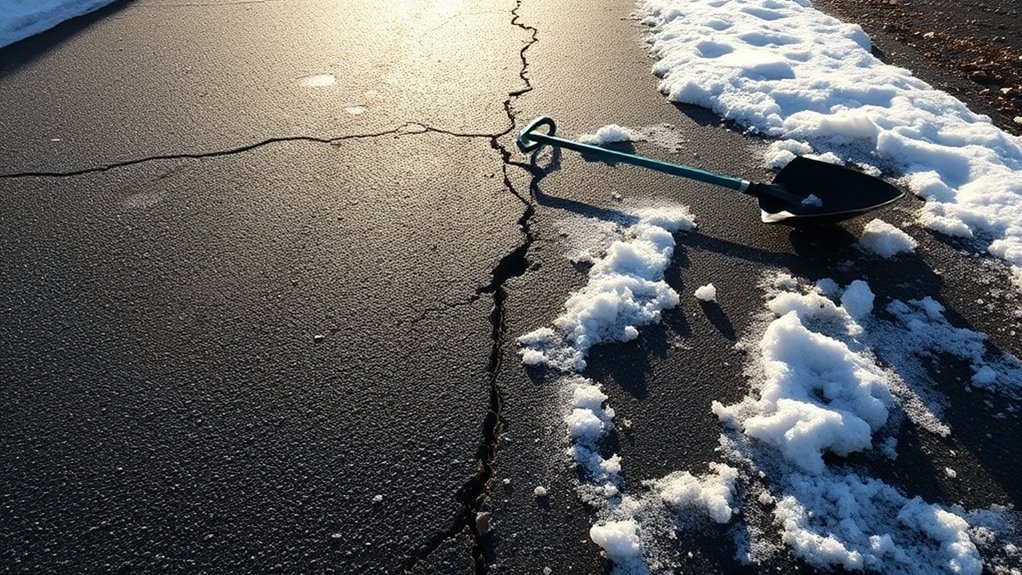
Mistakes in driveway sealing can lead to expensive repairs and reduced effectiveness. To help you steer clear of common sealing errors, keep these three driveway maintenance pitfalls in mind:
1. Improper Surface Preparation: Always ensure the driveway is thoroughly cleaned and any cracks or stains are repaired before sealing.
Skipping this step can result in poor adhesion and the sealant wearing away prematurely.
2. Choosing the Wrong Sealant: Select a sealant that’s specifically designed for your type of driveway material.
Using low-quality products can lead to rapid deterioration and inadequate protection.
3. Incorrect Application Timing: Avoid sealing during extreme weather conditions.
Make sure the driveway is dry and consider the time of year for optimal results.
Long-Term Effects of Sealing
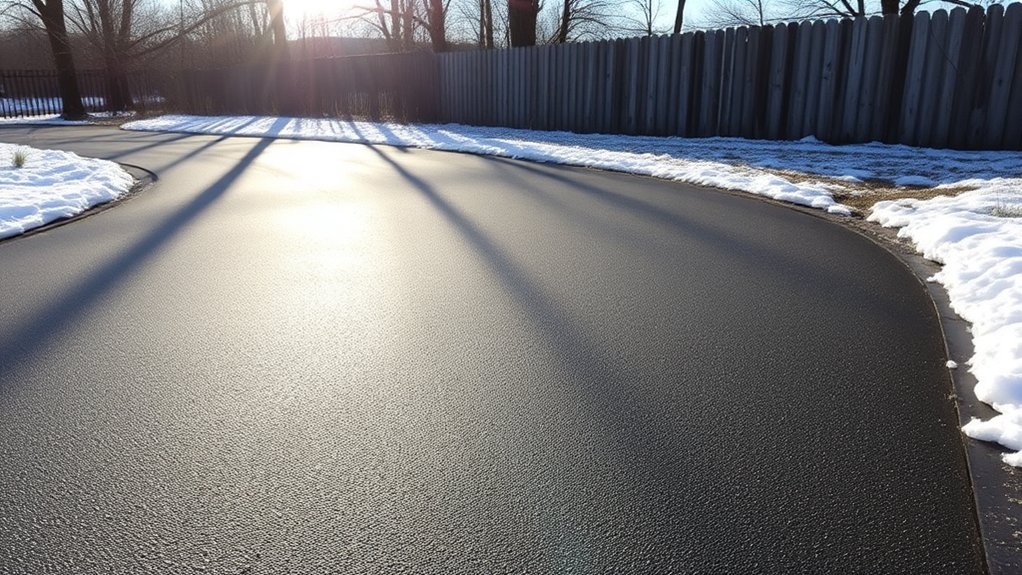
Sealing your driveway can significantly prolong its life by providing a protective barrier against harsh weather and wear.
It not only improves the appearance of your driveway but also helps minimise repair costs by preventing damage from rain and UV rays.
Extended Driveway Lifespan
Many homeowners underestimate the importance of driveway maintenance, but sealcoating can significantly extend the lifespan of asphalt surfaces. By applying a quality sealant, you can improve your driveway’s durability.
Here are three main benefits of sealcoating:
- Waterproof Barrier: Protects against water penetration, reducing damage from moisture.
- Reduced Oxidation: Limits exposure to air and UV rays, slowing down asphalt deterioration.
- Crack Prevention: Helps delay crack formation, maintaining your driveway’s structural integrity.
To maximise your driveway’s lifespan, aim to seal it every 2–3 years.
Different sealant types offer varying protection levels, so choose one that suits your climate and usage.
With proper maintenance, you can enjoy a driveway that lasts over 40 years, saving you money in the long run.
Enhanced Aesthetic Appeal
A well-sealed driveway not only boosts your home’s curb appeal but also helps maintain its appearance for years.
The sealing process restores your driveway’s original look, protecting it from weather damage and fading. It creates a uniform colour and texture, significantly enhancing your property’s aesthetics.
By covering minor flaws like cracks and stains, sealing ensures a smooth surface that impresses visitors and potential buyers alike. An attractive driveway indicates that your property is well cared for, potentially increasing its value.
With the benefits of sealing, your driveway will look fresh for longer compared to an unsealed one, requiring less upkeep and adding to your home’s overall charm.
Reduced Repair Expenses
Keeping your driveway looking good can also save you money in the long run. By sealing your driveway, you can significantly reduce repair costs.
Here are three main benefits:
- Reduced Repair Needs: Regular sealing decreases the frequency of crack filling and patching, resulting in fewer repairs over time.
- Budget-Friendly Maintenance: Sealcoating is much cheaper than major repairs or resurfacing, allowing you to manage your finances better.
- Longer Asphalt Life: Proper sealing shields your driveway from environmental damage, minimising the risk of expensive structural problems.
Investing in sealant now can lead to significant savings later on.
Understanding Freeze-Thaw Damage
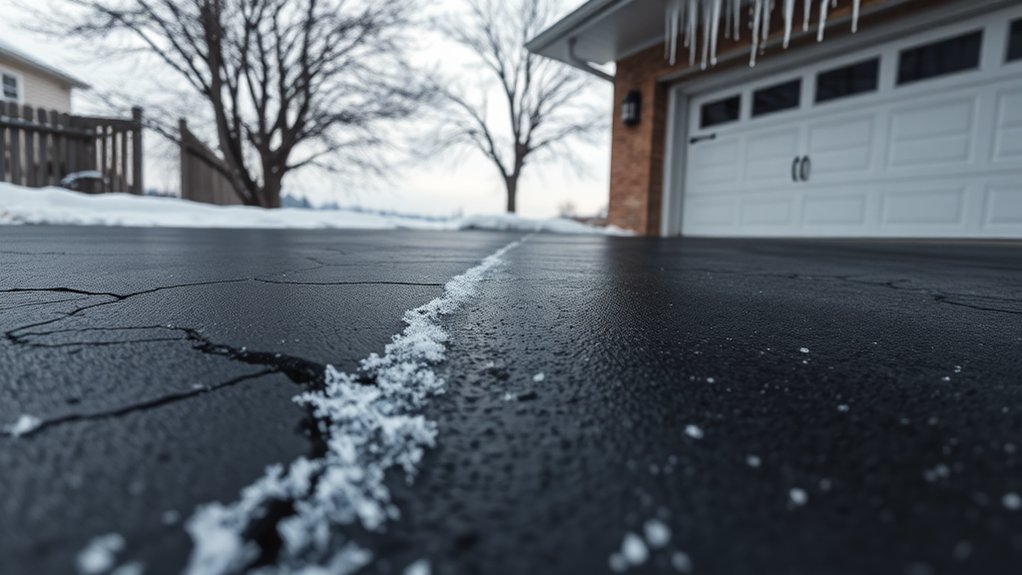
When water seeps into cracks in your driveway, it can cause serious freeze-thaw damage during the winter.
The process involves water freezing and expanding, which generates pressure that can exceed the strength of materials like concrete and tarmac. This ongoing cycle weakens the surfaces, leading to cracks and flaking.
Concrete is especially vulnerable, while tarmac may suffer from frost heaving due to ice forming beneath it. Each freeze-thaw cycle enlarges existing cracks, further undermining the driveway’s integrity.
To reduce this risk, it’s important to ensure proper drainage and seal your driveway to prevent moisture from getting in.
Regular maintenance is also crucial for long-term durability.
The Role of Temperature in Sealcoating
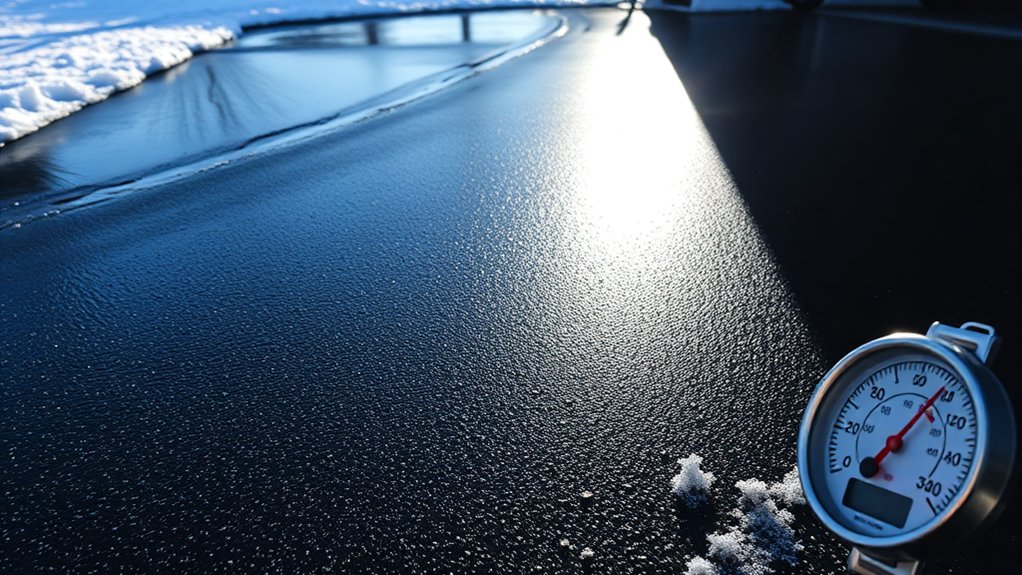
Understanding how temperature impacts sealcoating is crucial for safeguarding your driveway against winter damage. Here are three key points to consider:
- Applying sealcoat when temperatures are below 10°C can lead to poor adhesion, resulting in peeling and cracking.
- The ideal temperature range for application is between 21°C to 29°C, which ensures proper curing and durability.
- Temperature changes during curing can cause surface imperfections, making the sealcoat more vulnerable.
To ensure maximum adhesion and longevity, avoid sealing in cold or damp conditions.
Plan your sealcoating for late spring to early autumn when temperatures are more stable. This approach not only enhances the performance of the sealcoat but also protects your driveway from harsh winter conditions.
Enhancing Curb Appeal With Sealcoating
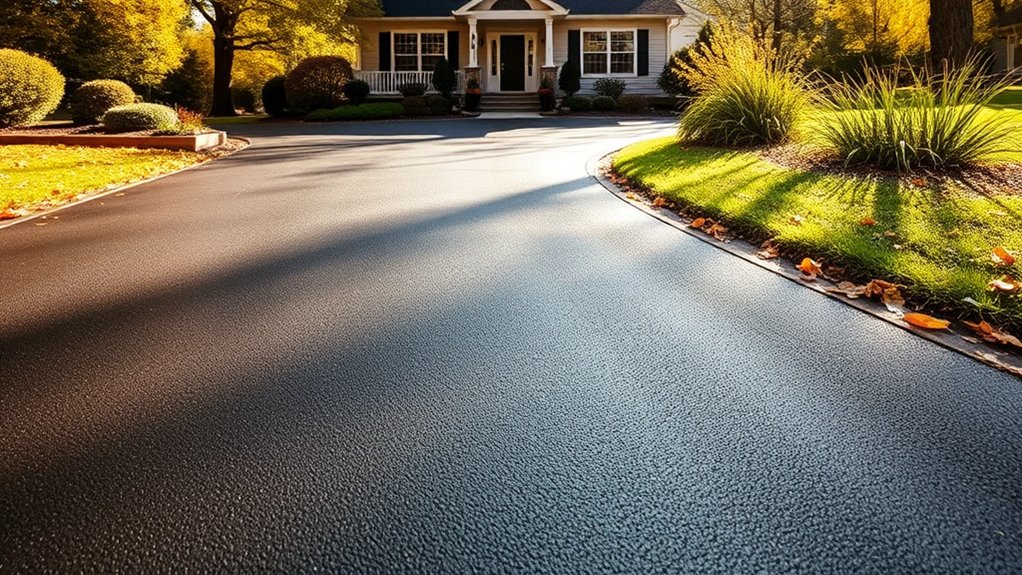
Enhancing your home’s curb appeal can be as straightforward as sealcoating your driveway. This process restores the deep, dark colour of your asphalt, giving it a smooth, glossy finish that stands out against dull, unsealed surfaces.
A freshly sealed driveway not only looks well-maintained but also shows your commitment to property care, which can impress visitors and potential buyers. The visual benefits of sealcoating improve your home’s overall appearance, making it more attractive and welcoming.
Additionally, a sealed surface is easier to clean and maintain, helping your driveway stay in top condition. By investing in sealcoating, you’re not just boosting curb appeal; you’re also protecting your investment for years to come.
Frequently Asked Questions
How Often Should I Seal My Driveway?
You should seal your driveway every two to three years for proper maintenance. Factors such as weather, foot and vehicle traffic, and the condition of the surface can affect how often you need to seal it. Look out for signs of wear, like cracks or fading, to determine when it’s time for a refresh.
Can I Seal My Driveway Myself?
Considering sealing your driveway yourself? With the right preparation, you can achieve benefits such as moisture protection and crack prevention. Just make sure to follow the proper steps for a successful DIY project!
What Type of Sealant Is Best for My Driveway?
For your driveway, consider using an asphalt sealant for its durability and water resistance. If you require flexibility, a latex sealant could be a suitable choice, offering protection while allowing for easier application and accommodating temperature fluctuations.
How Long Does Sealcoating Take to Dry?
When sealcoating, the drying time can seem quite lengthy. Typically, it takes around three to four hours before it’s safe to walk on. However, weather conditions can significantly affect this, so allow 24 to 48 hours before driving on the surface safely.
Will Sealing My Driveway Prevent Cracks Completely?
Sealing your driveway improves its durability and provides protection during winter, but it won’t entirely stop cracks from forming. Regular maintenance, such as sealing any cracks that appear, works alongside sealing to ensure your driveway can better withstand harsh weather conditions. For example, if you notice a small crack, addressing it promptly can prevent it from worsening and causing more significant damage.
Conclusion
Sealing your driveway before winter is a wise decision. It helps guard against freeze-thaw damage, improves the appearance of your property, and prolongs the life of your surface. For instance, a homeowner in the north of England sealed their driveway in October, avoiding expensive repairs after a harsh winter. By taking action early, you’ll save both time and money in the long run. So, don’t delay—make sure your driveway is prepared to face winter’s challenges and maintain its appeal for years to come.
Knowing whether your tarmac driveway needs sealing can save you money, but there's much more to consider before making a Read more
Uncover how tarmac driveways withstand freezing weather and learn essential tips for maintaining their durability in cold climates. Will your Read more
The potential savings from a DIY driveway installation are impressive, but the real question is, how much can you actually Read more

